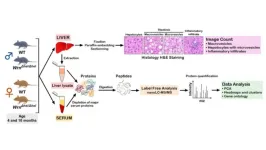(Press-News.org) An article published in the journal Insects determines with precision the dispersal range of a type of wasp that neutralizes the Brown stink bug, Euschistus heros, a major soybean pest in Brazil and highly resistant to chemical insecticides. The solution discussed by the authors is Telenomus podisi, a parasitoid micro wasp first described by American entomologist William Harris Ashmead in 1893.
Parasitoids are small insects whose immature stages develop either within or attached to the outside of other insects. They eventually kill the hosts they feed on, whereas parasites typically feed on hosts without killing them.
The findings of the study, which was conducted by scientists at São Paulo State University (UNESP) in Brazil and Oklahoma State University (OSU) in the United States, serve as a basis for improving the release of the egg parasitoid to assure biological control of E. heros, which also attacks cotton and sunflower plantations, as well as pasture.
The research has been supported by FAPESP via several projects (18/02317-5, 19/10736-0 and 18/19782-2).
Females of T. podisi locate eggs of E. heros in plants and lay their own eggs there, interrupting the stink bug’s development at an early stage.
“The pest’s eggs become dark in color and give rise to new wasps instead of bugs. These wasps go on to parasitize more eggs of the stink bug,” said Regiane Cristina de Oliveira, last author of the article and a professor in the Department of Crop Protection at the School of Agricultural Sciences (FCA-UNESP) in Botucatu (São Paulo state). Several studies have been conducted there to advise producers on the optimal way to use the biological control system by finding out how many wasps to release and estimate the right distance between release points, among other aspects.
The authors verified in field conditions that the parasitoid’s dispersal capacity, influenced by the soybean crop’s growth stage, varied between 31 m and 39 m, and that at most about 60% of the stink bug’s eggs were parasitized. Based on these results, they recommend that T. podisi release points should be no more than 30 m apart in order to assure sufficient control of stink bugs.
E. heros damages soybean seeds and pods and can cause yield losses of up to 30%. It lodges in the crop in the fall and stays there until summer, all the time accumulating lipids and not feeding but remaining quiescent (in a physiological state involving low metabolic activity).
Because its efficacy depends on the ability to find hosts, knowledge of its dispersal capacity enables growers to adjust logistics and release. “This optimizes management of the bugs via biological control programs implemented in large areas of monoculture,” said Oliveira, who has a first degree in agronomy from the Federal University of Espírito Santo (UFES), a master’s in agricultural entomology from UNESP, and a PhD in entomology from the University of São Paulo’s Luiz de Queiroz College of Agriculture (ESALQ-USP). She pursued postdoctoral studies at Mississippi State University (MSU) in the United States.
The other co-authors of the article are William Wyatt Hoback and Rafael Hayashida of OSU’s Department of Entomology and Plant Pathology; and Gabryele Ramos, Daniel Mariano Santos and Daniel de Lima Alvarez of FCA-UNESP.
About São Paulo Research Foundation (FAPESP)
The São Paulo Research Foundation (FAPESP) is a public institution with the mission of supporting scientific research in all fields of knowledge by awarding scholarships, fellowships and grants to investigators linked with higher education and research institutions in the State of São Paulo, Brazil. FAPESP is aware that the very best research can only be done by working with the best researchers internationally. Therefore, it has established partnerships with funding agencies, higher education, private companies, and research organizations in other countries known for the quality of their research and has been encouraging scientists funded by its grants to further develop their international collaboration. You can learn more about FAPESP at www.fapesp.br/en and visit FAPESP news agency at www.agencia.fapesp.br/en to keep updated with the latest scientific breakthroughs FAPESP helps achieve through its many programs, awards and research centers. You may also subscribe to FAPESP news agency at http://agencia.fapesp.br/subscribe.
END
Research optimizes biological control of pest that severely damages soybean crops
Scientists at São Paulo State University (UNESP) and Oklahoma State University (OSU) verified in the field that a parasitoid wasp that neutralizes the Brown stink bug should ideally be released at intervals of 30 m.
2024-06-03
ELSE PRESS RELEASES FROM THIS DATE:
Traffic speeds decrease when bike lane is present
2024-06-03
Rutgers University–New Brunswick researchers conducting a study at a high-traffic intersection in a Jersey Shore town have found that the installation of a bike lane along the road approaching the convergence reduced driving speeds.
As many traffic analyses have identified speeding as a contributing factor in a majority of crashes, inducing such a “traffic calming” effect with a bike lane could enhance road safety and decrease the risk and severity of crashes, the researchers said. The research was published in The Journal of Urban Mobility.
“We are giving you more evidence that bike lanes save lives,” said Hannah Younes, a lead author of the study and a postdoctoral ...
Proteomics uncover sexual dimorphism and immune changes in aging mice with Werner syndrome
2024-06-03
“Proteomics analysis at different ages allows us to follow the progressive biological alterations (including histological fat accumulation) in the liver according to age and/or the Wrn genotype.”
BUFFALO, NY- June 3, 2024 – A new research paper was published on the cover of Aging (listed by MEDLINE/PubMed as "Aging (Albany NY)" and "Aging-US" by Web of Science) Volume 16, Issue 10, entitled, “Integrated liver and serum proteomics uncover sexual dimorphism and alteration of several immune response proteins in an aging Werner syndrome mouse model.”
Werner syndrome (WS) is a ...
A technique for more effective multipurpose robots
2024-06-03
CAMBRIDGE, MA – Let’s say you want to train a robot so it understands how to use tools and can then quickly learn to make repairs around your house with a hammer, wrench, and screwdriver. To do that, you would need an enormous amount of data demonstrating tool use.
Existing robotic datasets vary widely in modality — some include color images while others are composed of tactile imprints, for instance. Data could also be collected in different domains, like simulation or human demos. And each dataset ...
Oral nucleoside antiviral is progressing toward future pandemic preparedness
2024-06-03
May 23, 2024
Obeldesivir (GS-5245), a novel investigational small molecule oral antiviral, represents a new tool in the ongoing effort to prepare for future pandemics.
Several researchers at the University of North Carolina at Chapel Hill’s Gillings School of Global Public Health are co-authors of a new study published online May 22 by the journal Science Translational Medicine.
The study shares findings from an academic-corporate partnership between biopharmaceutical company Gilead Sciences and the Sheahan ...
Shape and depth of ocean floor profoundly influence how carbon is stored there
2024-06-03
Key takeaways
The movement of carbon between the atmosphere, oceans and continents — or carbon cycle — regulates Earth’s climate, with the ocean playing a major role in carbon sequestration.
A new study finds that the shape and depth of the ocean floor explain up to 50% of the changes in depth at which carbon has been sequestered there over the past 80 million years.
While these changes have been previously attributed to other causes, the new finding could inform ongoing efforts to combat climate change through marine carbon sequestration.
The movement of carbon between the atmosphere, oceans and continents — the carbon ...
Airplane noise exposure may increase risk of chronic disease
2024-06-03
FOR IMMEDIATE RELEASE
Monday, June 3, 2024
Contact:
Jillian McKoy, jpmckoy@bu.edu
Michael Saunders, msaunder@bu.edu
##
Airplane Noise Exposure May Increase Risk of Chronic Disease
A new study found that people who were exposed to higher levels of noise from aircraft were more likely to have a higher body mass index, an indicator for obesity that can lead to stroke or hypertension. The findings highlight how the environment—and environmental injustices—can shape health outcomes.
Research has shown that noise from airplanes and helicopters flying overhead are far more bothersome to people than noise from other modes of transportation, ...
Mental health, lack of workplace support are leading factors driving nurses from jobs
2024-06-03
Coworker and employer support are strong predictors of nurses planning to stay in their jobs, while symptoms of depression are linked to nurses planning to leave, according to a study conducted at the height of the COVID-19 pandemic by researchers at NYU Rory Meyers College of Nursing.
The research—published in the Online Journal of Issues in Nursing, a journal of the American Nurses Association—examines both pandemic-related factors and the overall work environment for nurses and can help organizational ...
U.S. health departments experience workforce shortages and struggle to reach adequate staffing levels in public health
2024-06-03
Gaps persist in hiring enough U.S. public health workers and health departments continue to face challenges in recruiting new employees, according to a new study by Columbia University Mailman School of Public Health and Indiana University. Insufficient funding, a shortage of people with public health training, and a lack of visibility for public careers, in addition to lengthy hiring processes, are cited as barriers contributing to an absence of progress for achieving a satisfactory level of workers. The results ...
Redox Science Meets Medicine at the 26th International Conference on Redox Medicine 2024 this June in Paris
2024-06-03
Redox Science Meets Medicine at the 26th International Conference on Redox Medicine 2024 this June in Paris
The 26th International Conference on Redox Medicine 2024 will take place this month, on June 27-28 at Fondation Biermans-Lapôtre in Paris, France.
With 41+ communications and participants from 20 different countries, the conference promises a diverse exchange of knowledge and ideas.
The sessions of the conference are organized around key topics, with each speaker addressing a specific ...
Albert Einstein College of Medicine names Marla Keller, MD, Executive Dean
2024-06-03
June 3, 2024—(BRONX, NY)—Marla Keller, M.D., a national leader in academic medicine and in clinical and translational research and training, has been appointed executive dean at Albert Einstein College of Medicine. In this role, Dr. Keller will work closely with Yaron Tomer, M.D., the Marilyn and Stanley M. Katz Dean at Einstein, other executive leaders at the College of Medicine and Montefiore, and the Board of Trustees to achieve the vision for the institution. As Einstein’s second most senior officer, she will drive strategic planning for the College of Medicine and provide guidance across all academic and research programs.
Dr. ...
LAST 30 PRESS RELEASES:
New prostate cancer trial seeks to reduce toxicity without sacrificing efficacy
Geometry shapes life
A CRISPR screen reveals many previously unrecognized genes required for brain development and a new neurodevelopmental disorder
Hot flush treatment has anti-breast cancer activity, study finds
Securing AI systems against growing cybersecurity threats
Longest observation of an active solar region
Why nail-biting, procrastination and other self-sabotaging behaviors are rooted in survival instincts
Regional variations in mechanical properties of porcine leptomeninges
Artificial empathy in therapy and healthcare: advancements in interpersonal interaction technologies
Why some brains switch gears more efficiently than others
UVA’s Jundong Li wins ICDM’S 2025 Tao Li Award for data mining, machine learning
UVA’s low-power, high-performance computer power player Mircea Stan earns National Academy of Inventors fellowship
Not playing by the rules: USU researcher explores filamentous algae dynamics in rivers
Do our body clocks influence our risk of dementia?
Anthropologists offer new evidence of bipedalism in long-debated fossil discovery
Safer receipt paper from wood
Dosage-sensitive genes suggest no whole-genome duplications in ancestral angiosperm
First ancient human herpesvirus genomes document their deep history with humans
Why Some Bacteria Survive Antibiotics and How to Stop Them - New study reveals that bacteria can survive antibiotic treatment through two fundamentally different “shutdown modes”
UCLA study links scar healing to dangerous placenta condition
CHANGE-seq-BE finds off-target changes in the genome from base editors
The Journal of Nuclear Medicine Ahead-of-Print Tip Sheet: January 2, 2026
Delayed or absent first dose of measles, mumps, and rubella vaccination
Trends in US preterm birth rates by household income and race and ethnicity
Study identifies potential biomarker linked to progression and brain inflammation in multiple sclerosis
Many mothers in Norway do not show up for postnatal check-ups
Researchers want to find out why quick clay is so unstable
Superradiant spins show teamwork at the quantum scale
Cleveland Clinic Research links tumor bacteria to immunotherapy resistance in head and neck cancer
First Editorial of 2026: Resisting AI slop
[Press-News.org] Research optimizes biological control of pest that severely damages soybean cropsScientists at São Paulo State University (UNESP) and Oklahoma State University (OSU) verified in the field that a parasitoid wasp that neutralizes the Brown stink bug should ideally be released at intervals of 30 m.



